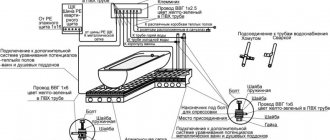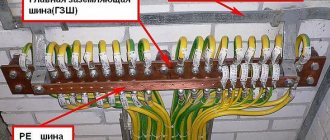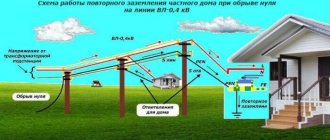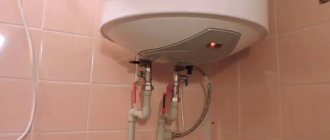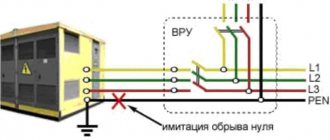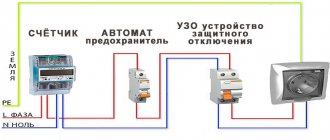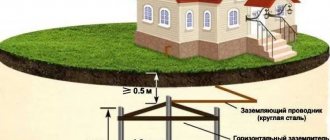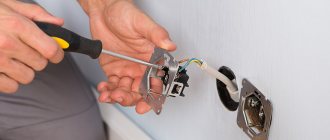Many owners, when deciding to carry out a major renovation of their bathroom, argue whether it is necessary to ground a cast-iron bathtub. Some argue that this is not necessary. Others voice the opposite opinion and give reasons for it. Those who advocate earthing are right. This is a direct path to safety.
As for the opinion of professionals, they are sure that circuit protection is necessary. Until there was no analogue to the metal elements of the pipeline, they were grounded according to simple instructions. Professionals connected the cable to a metal riser.
Today the situation is different. If those living below repair the pipes and replace them with polyethylene elements, the grounding automatically disappears. Therefore, the bath must be connected to a functional grounding bus, bringing it to the shield.
What is grounding
Apartment owners have at their disposal various electrical appliances made of metal. They must be grounded. The standard bath is no exception. This is a direct source of increased danger. Old cast iron, steel, and acrylic structures should be grounded.
Acrylic is a material that does not conduct current, but accumulates a static charge. The situation is worsened by the fact that bathtubs made of acrylic are installed on metal elements. They are a direct conductor of current.
Grounding in the bathroom is required. This is not difficult to do, but it is still better to entrust the process to an electrician. Lack of necessary skills will lead to negative consequences. It is not advisable to conduct independent experiments.
How to ground plumbing and why it needs to be done
Modern apartments are in most cases overcrowded with a variety of household appliances and metal products. The bathroom is no exception. In small toilet rooms you can see a large selection of electrical appliances and plumbing items that are potentially dangerous to humans. Even an acrylic bathtub is included in this list, although it is made of dielectric material. This product is capable of accumulating a powerful charge of static electricity, which can cause significant damage to a person. In addition, the acrylic container is installed on a metal frame, and it conducts electricity well.
All this suggests that grounding in the bathroom must be created, although there are no special requirements in regulatory documents in this regard. For a private house or country house, creating a grounding loop in the bathroom will not be difficult, but in apartments of multi-storey buildings you will have to bring out the grounding wire to the floor distribution board and connect it to a special bus. We will consider below how to protect various plumbing items from the appearance of dangerous electric voltage on them and how to ground a bathtub in an apartment.
Important! The grounding conductor has green-yellow insulation and is designated on the wiring diagrams by the letters PE. This is necessary in order not to confuse the grounding cable with the power lines of the facility's power supply.
Grounding old bathtubs
In Soviet times, cast iron or steel were mainly used to make bathtubs. These products did not provide special structural elements that are necessary to connect the ground wire. But this problem can be solved quite simply! To complete the work, you will need the following tools and materials: an electric drill, a drill with a pobedit tip, a jumper for connecting the ground wire, a set of fasteners (bolt, washers and nuts), as well as a stranded copper cable and a distributor of all ground taps.
A hole of the required diameter is drilled in the bathtub leg and a grounding jumper is installed on the threaded connection. A grounding conductor is attached to the jumper and brought out to the switchgear. The device itself must be secured in a convenient place, since all grounding wires from metal products located in the bathroom will be connected to it. From the distributor, the common grounding wire must be led to the distribution board on the floor landing and connected to the protective grounding bus. All this work is quite simple and can be done with your own hands.
Grounding modern cast iron and steel bathtubs
Grounding cast iron bathtubs manufactured in the last decade will not cause problems even for an inexperienced consumer. All of them are equipped with special petals with a mounting kit for connecting the grounding conductor. Simply tighten the bare end of the wire between the washers and bring it out to the distributor. If for some reason the jumper is missing, a hole will need to be drilled. It is best to perform this operation on special thickenings of the bathtub body, which are designed to wedge the load-bearing legs of the product. This option will create reliable contact between the ground wire and the bathtub.
There will be no special problems with steel bathtubs either. They usually have a petal and do not need to drill a hole. It is enough to strip the enamel coating around the hole on the petal down to the metal and use a crimp screw to secure the grounding conductor. All other operations must be performed by analogy with cast iron baths. Next, we will consider the question of whether it is necessary to ground an acrylic bathtub and how to do this work correctly.
Attention! It is prohibited to connect the ground to the removable legs of steel and cast iron bathtubs. This is due to the fact that there is no normal electrical contact between the supporting elements and the bathtub itself!
Grounding acrylic bathtubs
Acrylic bathtubs are becoming very popular sanitary products. It is they who are gradually ousting steel and cast iron products from the market. The main advantage of acrylic bathtubs is their light weight, but at the same time this is a definite disadvantage. There are two types of such products: cast and extruded. The second type of acrylic plumbing products is installed on steel frames, and as we know, metal is an excellent conductor of electricity. Therefore, acrylic bathtub frames must be grounded. Grounding an acrylic bathtub is carried out by analogy with steel products.
Important! Water getting between the body of an acrylic bathtub and the supporting metal frame can lead to the formation of a conductive layer, so this structure must be grounded!
Jacuzzi grounding
If we can argue about the need to ground various models of bathtubs, then for Jacuzzis (hydromassage baths) this procedure is mandatory! This plumbing product is a complex household appliance that consumes electricity, and any electrical appliance in the bathroom must have protection against the appearance of mains voltage on its body. Hydromassage baths are connected to the grounding bus through special sockets designed for installation in rooms with high humidity. They have special curtains in their design that protect the contacts from water getting on them.
Sockets for connecting a jacuzzi are installed at a distance of 30 cm from the floor of the bathroom and 50 cm from the edge of the whirlpool bath. The cable for supplying electricity and the grounding conductor must be double insulated and placed in a corrugated pipe. For a Jacuzzi, a separate RCD and circuit breaker must be installed in the switchboard; in addition to grounding, this will ensure reliable protection of a person from electric shock. The PUE rules prohibit grounding hydromassage baths through the water supply system. It is advisable to involve an experienced electrician in the installation of a jacuzzi, as this will allow you to avoid errors when connecting.
Attention! When installing electrical wiring and protective grounding cables, the use of twists and other unreliable connections that can lead to a broken contact and electric shock to a person is not allowed!
Grounding the heated towel rail
How to ground a stainless steel heated towel rail and is it necessary? The answer to this question can be found in physics textbooks and reference books! There are such concepts as galvanic corrosion and stray currents. These two unpleasant phenomena can reduce the life of the heated towel rail to a minimum! Stray currents occur when electrical energy leaks into the heating system from damaged wiring, household appliances, and for some other reasons. Galvanic corrosion occurs when two dissimilar metals interact with water, which is to some extent an electrolyte.
These two factors can damage a stainless steel heated towel rail, so it should be grounded. Heating systems consisting of metal pipes are initially grounded and additional grounding is not required to equalize potentials on the heated towel rail. But if the heating pipes are plastic, then it is better to connect it to a common ground bus on the distribution board. This operation will not cause any difficulties; it is enough to secure the grounding conductor to the heated towel rail using a metal clamp and remove its zero bus.
Wire selection
The town house bathroom uses 6mm stranded cable. This is enough to ensure a high level of electrical safety for people living in the apartment. A similar cable is suitable for heated plumbing. It must be durable, copper. But it is permissible to use a cable made of steel. It usually has a copper shell.
It is better to disguise the cable. Any wire located outside spoils the interior.
Features of bathroom wiring
The bathroom is a room with high humidity, so there are special requirements for wiring here. During work, a triple-braided cable with a grounding conductor is used. Distribution boxes and a large number of switches and sockets cannot be installed in bathrooms. Nowadays, apartments are equipped with powerful electrical appliances, such as boilers or washing machines. In this case, you need to lay wires with a larger cross-section that will not overheat when the equipment is turned on.
Sometimes people feel a slight tingling sensation when taking a bath. This happens when the integrity of the cable braid is damaged. Water is a good conductor of electricity, which is transmitted to humans. Over time, a powerful charge builds up that can kill. The protective circuit removes electricity and prevents the occurrence of traumatic situations.
Dividing the room into separate zones
When choosing an installation location, you must follow the rules and be guided by the PUE, and all distances must be observed, including the installation height of sockets. It is recommended to arrange the sockets in such a way that in the event of a breakdown, they have easy access for replacement or repair. To avoid violations of installation rules, the entire bathroom room is conditionally divided into several zones.
According to regulatory documents, the entire territory of the bathroom is conditionally divided into several zones. They determine the degree of safety and allow you to most optimally develop a plan for the placement of electrical appliances and equipment, laying wiring to each point in the shortest possible way.
The conditional division of the bathroom includes the following zones:
- Zone 0: Covers the inside of the shower tray and the inside of the bathtub. It is not possible to place any waterproof electrical equipment in this location.
- Zone 1. Located directly above the shower tray, bathtub, washbasin or sink, at a height of 2.5 m from the floor level.
- Zone 2. Located up to 60 cm in all horizontal directions from cabinets, shower tray, bathtub or sink. The height from the floor is up to 2.25 m. It covers the area above the 1st zone at a height of 3 m from the floor.
- Zone 3. Overlaps the 2nd zone by 2.4 m, maintaining a height from the floor of 2.25 m. The height above the 2nd zone is up to 3 m. Based on these parameters, the height of the sockets in the bathroom is determined.
Importance
Remember, water is an unrivaled conductor of electricity, so the bathroom has always been and will remain the most dangerous place in your home.
Do I need to ground the bathtub? - a question that has only one answer - positive. Every plumber will convince you to protect yourself and your family, and it’s not worth taking risks with electric shock.
A grounding loop is a necessary detail in rooms like a bathroom, that is, with high levels of humidity.
Let's take a closer look at why you need to ground the bathtub: for safe use of the bathtub by the whole family, to equalize the electrical power of any current-conducting surfaces. It is very important to consider the grounding effect globally, taking into account other plumbing and household appliances in the bathroom. Otherwise, grounding the bathtub will only be pointless.
The safety of the bathroom will also be determined by the correct installation of all appliances in the room, taking into account the rules and regulations for correct electrical installation.
A little theory
Note!
Most modern electrical household appliances have special metal grooves for “grounding”.
This term means special protection that takes electric current when it appears on the equipment body and leads it to the ground.
Each of us at least once in our lives felt electric shocks when touching an electrical appliance. This often happens when working with a washing machine, computer, or when touching a water heater, when a breakdown of the heating element causes an electric current to pass through the water.
All this happens because electrical wiring is installed in our apartments and houses, often without taking the necessary safety measures. But when organizing a grounding device, electric current breakdowns on the housings of devices and equipment will not be felt.
